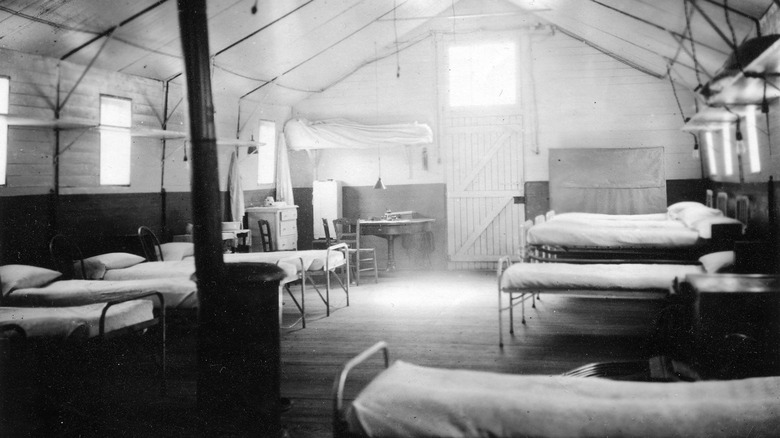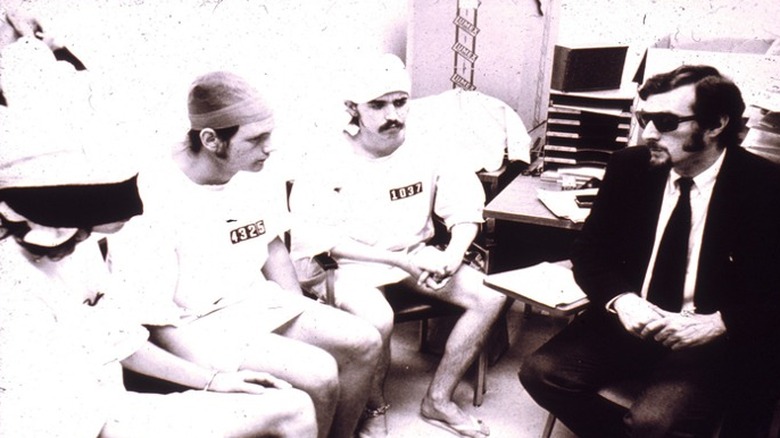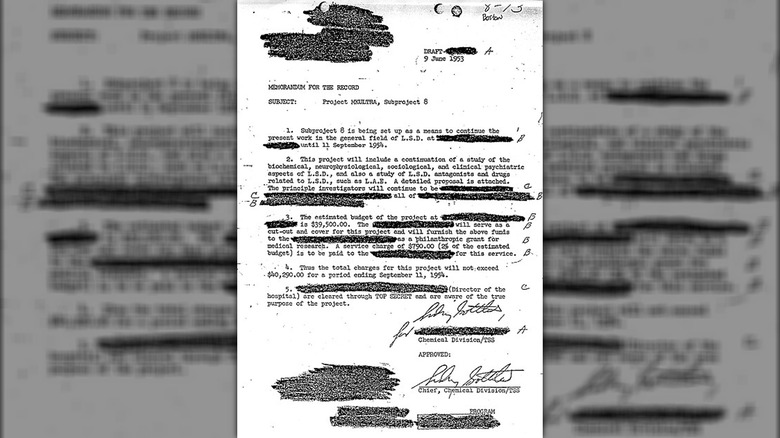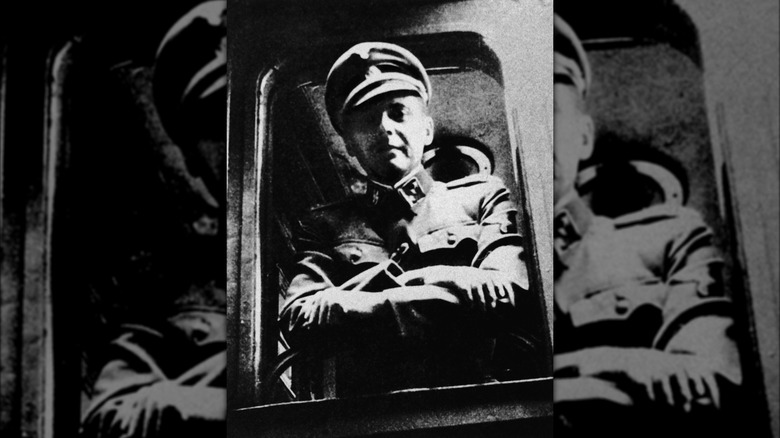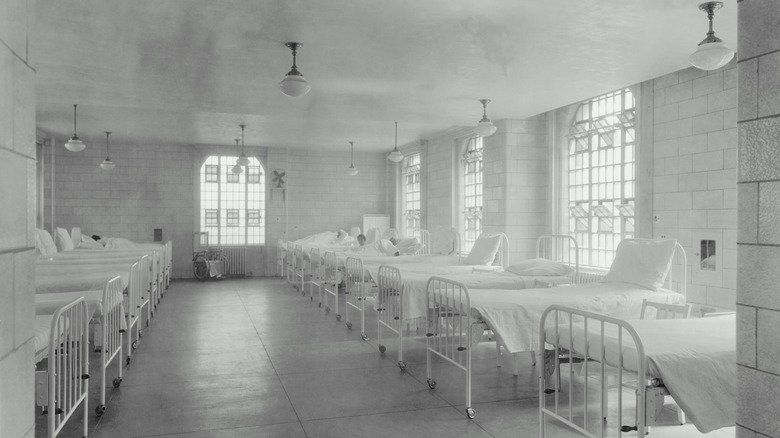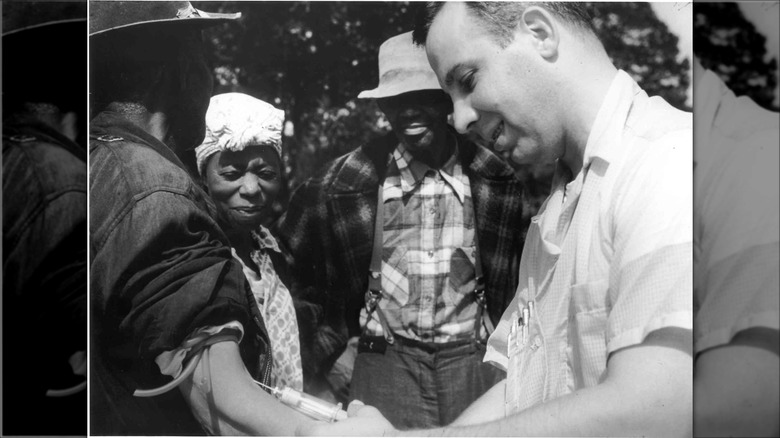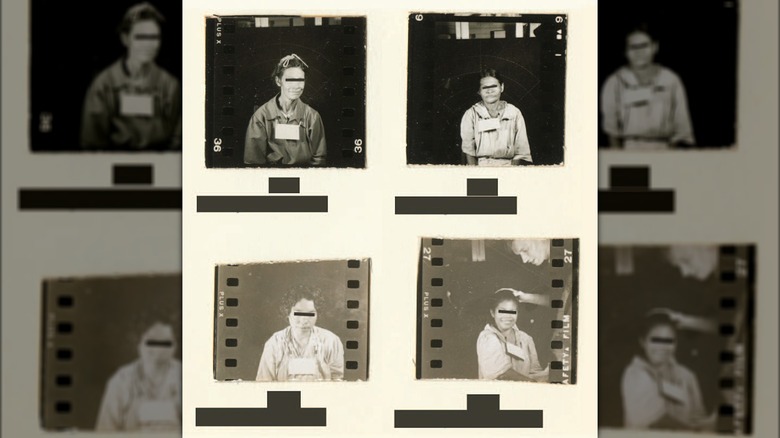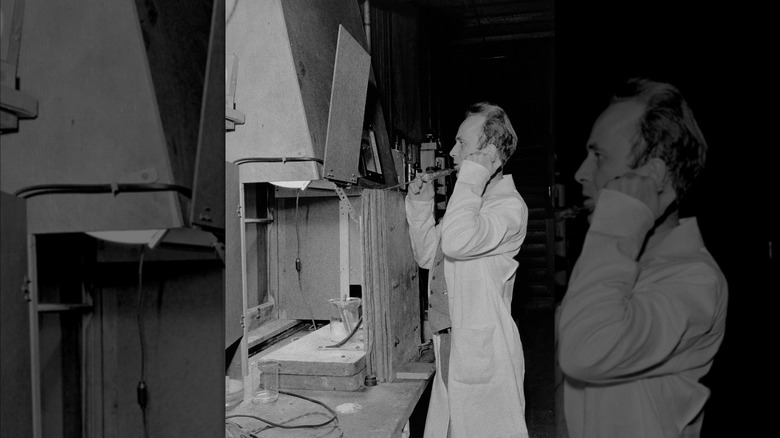The Most Terrifying Human Experiments In World History
Most of the time, scientific progress is a very positive thing: studies that add to the overall understanding of how the world works. It's an admirable goal, and in reasonable circumstances, arguing against that isn't the easiest thing.
Sometimes, the circumstances are less than reasonable, and the desire to learn and experiment starts to cross the line into the ethically and morally gray. The push toward progress can come with a pretty heavy cost, potentially hurting a lot of people in the process. Human experimentation typically falls along these lines, but even then, there are some projects throughout world history that stand out, and for the worst reasons. Harmful effects on health and dubious consent tend to be pretty common factors in many of the worst of these studies. However, their legacies can sometimes differ, with some achieving infamy while others have managed to slip through the cracks of history.
Similarities and differences aside, though, here are just a few of the most terrifying human experiments ever conducted.
Project 4.1
When it comes to human experiments, Project 4.1 is an odd one. While researchers might have had less of a hand in inflicting terrible circumstances on their subjects, there's still some dubious morality that's worth considering.
For some context, during the 1940s and 1950s, the U.S. used the Marshall Islands as a testing ground for nuclear weapons and research, but it's important to note that these aren't empty, abandoned islands. On the contrary, they'd been inhabited for a long time, yet American tests weren't exactly as carefully planned as you would hope. Even relatively contained tests began raining radiation down on the local population, and public health became a growing concern.
That's where Project 4.1 comes into play, and perhaps its official name — "The Study of Response of Human Beings Exposed to Significant Beta and Gamma Radiation Due to Fallout from High Yield Weapons" — can give some insight into just where the ethics get murky. In effect, the inhabitants of the Marshall Islands became test subjects of convenience, a way for scientists to see the unintended consequences of a mess they had made. None of the locals knew that they were involved in any study; all they knew was that they were being treated for vague illnesses that they were told little about. All the while, of course, they were also dealing with the effects of radiation poisoning — congenital disabilities as well as social tensions — all while their requests for help were largely brushed aside.
The Stanford Prison Experiment
When you think about awful human experiments, there's a pretty good chance that the Stanford Prison Experiment comes to mind, and that's not without good reason. After all, recreating the conditions of a prison, such that reality turns into some "Lord of the Flies" type of nightmare, is more than a little scary.
If you're unfamiliar with it, the Stanford Prison Experiment was a 1971 study conducted by Philip Zimbardo that took a group of male college students and had them simulate the conditions of Stanford County Prison (which was really the basement of the Stanford University Psychology Department). The participants were separated into two groups: prisoners were humiliated from the outset, and guards were put into positions of authority and power. And things quickly devolved from there. Guards began to assert their power through cruelty and both physical and psychological punishment; prisoners experienced deep depression on more than one occasion and, on another occasion, staged a total rebellion (which was meant with even harsher reprisals). The ethics were murky, and the experiment ended after six days despite being planned to last two weeks.
Discussions surrounding the Stanford Prison Experiment have only gotten even more complicated in the years since. From the start, it was likely flawed — selection bias came into play, and even then, some participants admitted to playing up their actions and responses precisely because they knew it was all fake. It's not the best grounds to draw any accurate conclusions.
[Featured image by Philip Zimbardo via Wikimedia Commons | Cropped and scaled | CC BY-SA 4.0]
MK Ultra
To put it pretty simply, MK Ultra sounds a lot like "The Manchurian Candidate." The idea that Cold War-era communist countries were somehow brainwashing American soldiers overseas was, in fact, a very real concern. And so, naturally, the U.S. government decided to try and weaponize mind control themselves, with all of that research getting rolled up under the purview of MK Ultra.
The project was fairly wide reaching, including just about any experiment that had to do with psychological manipulation. Hypnosis was quite possibly the most tame method, especially considering that electro-shock therapy and exposure to radiation or mind-altering drugs were also on the table. What's more, the actual means by which these experiments were carried out were far from ethical. Participants in these studies often weren't fully aware of exactly what they were signing up for, and even if you were to look past the dubious consent, then you'd find that MK Ultra targeted specific groups. Prisoners and patients in mental hospitals were easy targets, and the stories of their experiences are harrowing — feeling like their bones were melting or losing their ability to understand they were human was just the start.
Unsurprisingly, all of this was done in secret, with the CIA denying they were capable of such things. But word began to get out in the early 1960s, with congressional hearings taking place in the 1970s. Ultimately, those hearings weren't too effective — CIA staff claimed not to remember, and files were very conveniently destroyed — so the exact details might be even worse than those the public is aware of.
Operation Midnight Climax
In 1955, you could easily find an unassuming little house in San Francisco, tucked away on Chestnut Street. Outwardly, there wasn't much you could say about it, but if you started to pull away the curtains, you'd find something much more sinister: This was actually the site of a CIA experiment, one called Operation Midnight Climax.
To be technical about things, Midnight Climax was just one part of MK Ultra, the CIA's wide-reaching experimentation surrounding mind control, but it was awful enough to build up a notoriety all its own. Specifically, it was meant to focus on a particular fascination with LSD, but the execution was hardly scientific. Sex workers were hired to lure unsuspecting victims to the house, and once there, these victims became unwitting subjects, dosed with LSD. Meanwhile, behind the two-way mirror, those in charge of the experiment would just sit and watch. All while apparently having a pretty good time.
The ethics behind this are obviously questionable for many reasons, but it gets even worse. George White — the man who was officially in charge — had intentions rather divorced from drug research: voyeurism. Sure, there were discussions of how to use sex to extract information and the like, but White clearly had more self-serving interests in mind. After all, according to the man himself: "Where else could a red-blooded American boy lie, kill, cheat, steal, rape, and pillage with the sanction and blessing of the All-Highest?" (via The San Francisco Chronicle).
Nazi experiments
It doesn't need to be said that the Nazis committed plenty of atrocities during World War II (and that's putting it very lightly). But there was more to Nazi atrocities than death camps and gas chambers; the medical experiments were a horror show all their own.
Victims of Nazi science were often Jewish or Romani prisoners in concentration camps — usually those who were deemed unfit to work — and their torture was justified under the Nazi regime as being in search of a way to prove racial supremacy. Hardly an acceptable reason, and it was only made all the worse when you considered what the experiments were. Methods of mass sterilization were a popular area of study — awful for both the fact that said methods were actively tested on innocent victims, and the fact that the intentions were, effectively, genocidal. Work was also done when it came to research on disease, though that work was accomplished by knowingly infecting victims just to see what different cures might do. Then, there was also murder, just to have more bodies to study.
All of it was bad enough to ultimately lead to infamy. After all, it's hard not to think of Nazi experiments and not hear about Joseph Mengele (pictured), known literally as the "Angel of Death" and remembered primarily for his (often lethal) experiments on twins.
Unit 731
When it comes to human experimentation during World War II, the first thing to come to mind is most likely the inhumane science carried out by Nazi doctors. But for as bad as all of that was, Nazi Germany wasn't the only nation guilty of some very twisted experimentation in the 1940s; after all, Japan had Unit 731.
In short, Unit 731 was a secret research branch operating primarily out of regions of China under Japanese control. From its inception in 1938, it focused on testing what the human body could endure. And that meant a whole lot of different things, all of them terribly inhumane and often deadly. Chinese prisoners would sometimes find themselves the subjects of vivisections. The reason why? To see what their internal organs looked like before death. Others were the subjects of vicious frostbite tests, having their limbs frozen, then thawed out by whatever means their captors chose. And that was if their limbs hadn't been amputated for no real reason other than to see what happened. In other cases, victims were subjected to insane situations to see what their bodies could handle: starvation, dehydration, deadly G-forces in centrifuges, or just having large objects dropped on them. Then, there was also weapons testing, which included subjecting people to flamethrowers, bayonets, nerve agents, and exposure to X-ray radiation.
Thousands of people died in those experiments (though the exact statistic remains a mystery), and Unit 731 was kept a secret for decades.
The Aversion Project
Just speaking in general, the racial segregation instituted by apartheid in South Africa during the 20th century was a very obvious problem. But during that time, segregation and oppression were determined by more than just race, and looking to the South African military would find an example in the Aversion Project.
The Aversion Project was an attempt by the South African military to "cure" gay soldiers of their sexuality, and, honestly, the explanation as to why it was so twisted could almost end there. That said, the devil is truly in the details. Many gay men were forced into psychiatric care, where they were given so-called aversion therapy — usually electroshock therapy, in reality, using voltages that were so high they reportedly sent one victim's shoes flying. Not that electricity was the only method being tested — chemical castration, hormone therapy, and unwanted sex-change operations were also on the table and used in thousands of cases. Even outside of the horrific treatments, life in these hospitals hardly focused on healing, with armed guards patrolling the halls and drugs used liberally on all patients — Valium for everyone and a strange "truth drug" that doctors could freely use during interrogations. Far from a welcoming place.
Ultimately, the project was abandoned, and it's done nothing but leave a bitter legacy. The man in charge, Dr. Aubrey Levin, admitted to his failure but not to his human rights violations, and the project itself was just one facet of widespread homophobia at the time.
The Tuskegee Syphilis Study
Syphilis is not something to be taken lightly. Fortunately, its cure is something that sounds very simple nowadays — just a shot of penicillin. So, you would hope there wouldn't be any real reason to deny anyone treatment, right?
Well, if you went back to 1932, you'd find an alarming answer to that question, because that was the start of the Tuskegee Syphilis Study. The point of the study was to track the progression of the disease in hundreds of Black men living in Alabama, which wasn't necessarily ill-intentioned at the outset, as syphilis still didn't have a cure. But come 1947, penicillin was the recognized cure for the disease, and that's where ethics began to turn murky. Physicians had the means to treat hundreds of infected patients, but they just didn't, all because the U.S. Public Health Service valued their experiment over human lives. Officials urged that the men involved in the study continue to receive little more than placebos as their conditions worsened — and that included blindness, insanity, and death on more than a few occasions.
Worse still? The study went on unimpeded for decades, and even upon investigators discovering it in the 1960s, the project was both allowed to continue and explicitly intended to continue until its subjects died. The project didn't come to an end until it was leaked to the public in 1972 — 40 years and over 100 deaths after its inception.
The Guatemala Syphilis Experiment
The Tuskegee Syphilis Study is notorious for good reason; denying treatment to a population simply in the pursuit of cold-hearted academic study with little regard for life is an obvious problem. But American officials took things even further during the lesser-known Guatemala Syphilis Experiment. This wasn't a denial of treatment but a calculated spread of disease.
With the discovery of penicillin as a cure for syphilis during the early 1940s, public health officials wondered at its efficacy and how best to employ it. By the middle of the decade, they'd devised a way to answer that question: building a hospital in Guatemala where they could treat people infected with diseases including syphilis and gonorrhea. But this was far from charity. Instead, they intentionally infected members of the local population — in some cases through the use of infected sex workers, and in other cases by directly injecting people with the disease (typically done to prisoners and patients in psychiatric hospitals). Of course, none of these people had any idea what was happening, nor could they consent to participating in a study that could, honestly, threaten their lives. While it's true that the aforementioned hospital provided treatment to the infected, it's hard to ignore the fact that, over the course of two years, well over a thousand people were affected in the process, including both young children and the elderly.
Radiation experiments
Radiation was a hot topic during the 1940s and 1950s, and understandably so. Scientists at the time had plenty of reasons to learn precisely how dangerous radiation was to the human body. But it's difficult to justify the lengths they went to, because their experiments involved a lot of human experimentation and little consent.
There are several different examples of this — the 1945 Vanderbilt Nutrition Study, for instance, in which hundreds of pregnant women were, without their knowledge, given drugs with traces of radioactive iron. And there was an experiment conducted around the same time in which schoolchildren were fed radioactive calcium, fully backed by the U.S. government.
Perhaps the most egregious, though, were the plutonium injection experiments. And the name tells you most of what you need to know, as researchers wanted to see how radioactive materials were absorbed by the human body. Around 30 supposedly terminally ill patients were unknowingly injected with radioactive plutonium, in some cases at doses far above the lethal limit or with plutonium isotopes that were known to be especially radioactive. Records of these injections were kept secret — very intentionally, to avoid the expected public outcry — and off of normal hospital charts. Consent was only given in, at best, one of those cases, and, to make the situation even more twisted, at least a handful of those patients weren't even terminally ill. One was a 2-year-old child who died less than a year after being injected.
